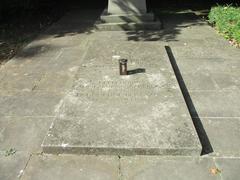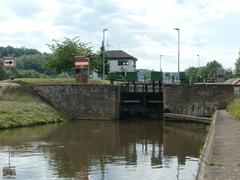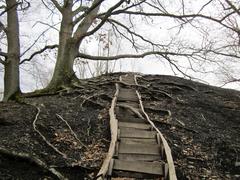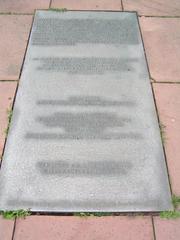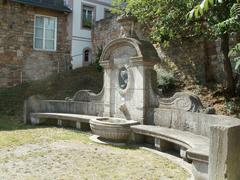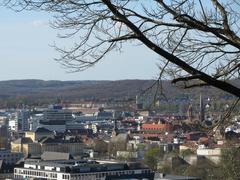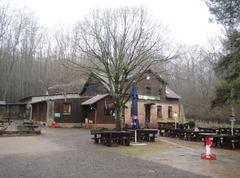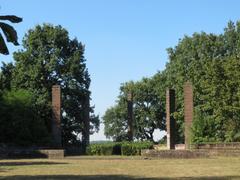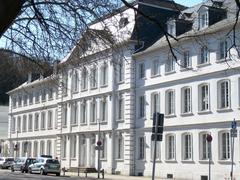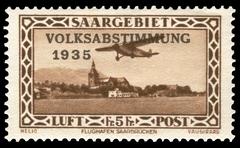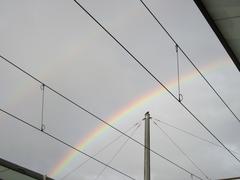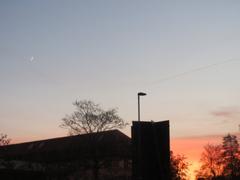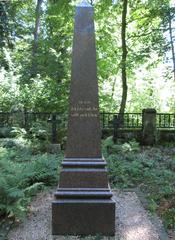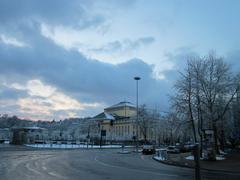War Memorial in Saarbrücken: Visiting Hours, Tickets, and Historical Significance
Date: 03/07/2025
Introduction
Saarbrücken, the capital of Saarland near the French border, is a city whose landscapes, monuments, and memorials narrate a profound story of conflict, resilience, and reconciliation. Its war memorials commemorate the tragedies and transformations brought by the Franco-Prussian War, both World Wars, and the shifting political landscapes of the 20th century. Sites such as the Nußberg War Memorial, the Invisible Memorial Square (Platz des Unsichtbaren Mahnmals), and the Historical Museum Saar offer visitors both solemn spaces for remembrance and powerful opportunities for reflection on peace, memory culture, and the ongoing process of European reconciliation.
This comprehensive guide details the historical background, symbolism, practical visitor information, and broader societal significance of Saarbrücken’s war memorials. Whether you wish to explore the artistic symbolism, participate in commemorative events, or simply pay your respects, this overview will help you make the most of your visit.
For more on the unique concept behind the Invisible Memorial Square, see Platz des Unsichtbaren Mahnmals. Further details on the Nußberg War Memorial and other sites are available via Traces of War and the Historical Museum Saar.
Contents
- Historical Context and Significance
- Saarbrücken’s Strategic Importance
- From the Franco-Prussian War to the Saar Protectorate
- Key War Memorials in Saarbrücken
- Nußberg War Memorial
- Invisible Memorial Square (Platz des Unsichtbaren Mahnmals)
- Historical Museum Saar and Other Memorials
- Symbolism, Art, and Societal Relevance
- Visiting Information
- Hours, Tickets, Accessibility
- Tours, Etiquette, and Nearby Attractions
- Frequently Asked Questions (FAQ)
- Conclusion
- Sources and Further Reading
Historical Context and Significance
Saarbrücken’s Strategic Importance
Situated on the Saar River, Saarbrücken’s location has long rendered it a focal point of European history. Prosperity in the 18th century under Prince William Henry, who nationalized coal mines and promoted early industrialization, established Saarbrücken as a hub of commerce and culture. Architectural gems by Friedrich Joachim Stengel—including Ludwigskirche and Friedenskirche—still adorn the city (Wikipedia).
From the Franco-Prussian War to the Saar Protectorate
Saarbrücken’s role in the Franco-Prussian War was marked by the occupation by French troops in 1870, commemorated at the Lulustein memorial. After World War I, the Treaty of Versailles placed Saar territory under League of Nations administration, with France controlling coal mines. The 1935 plebiscite led to Saarland’s return to Germany (Wikipedia).
World War II brought devastation—Allied bombings destroyed much of the city and claimed over 1,200 civilian lives. Post-war, Saarbrücken became the capital of the French-administered Saar Protectorate before rejoining Germany in 1957 (Wikipedia).
Key War Memorials in Saarbrücken
Nußberg War Memorial
Located on Nußberg hill (coordinates: 49.225536, 6.991821), this memorial honors residents of Saarbrücken lost in both World Wars (Traces of War). Its tranquil setting invites contemplation and remembrance.
Visitor Information:
- Hours: Open year-round; best visited 9 AM–6 PM.
- Tickets: Free entry.
- Accessibility: Accessible, but some hill terrain may challenge those with mobility impairments.
- Nearby: Walkable to Saarbrücken Castle and the Historical Museum Saar.
Invisible Memorial Square (Platz des Unsichtbaren Mahnmals)
This exceptional memorial lies beneath the Schlossplatz in front of Saarbrücken Castle, commemorating over 2,100 Jewish cemeteries destroyed or abandoned during the Nazi era. The names of these cemeteries are engraved on the undersides of 2,146 cobblestones, rendering the memorial “invisible” except for a subtle street sign and informational plaques (Platz des Unsichtbaren Mahnmals).
Visitor Information:
- Hours: Open 24/7.
- Tickets: Free.
- Accessibility: Flat and accessible.
- Recommended: Pair your visit with a tour of the adjacent Historical Museum Saar for deeper context.
Historical Museum Saar and Additional Sites
Beneath Saarbrücken Castle, the Historical Museum Saar showcases the city’s multifaceted history, including exhibits on war, resistance, and daily life (Historical Museum Saar). Notable features include preserved Gestapo cells and medieval fortifications.
Visitor Information:
- Hours: Tue–Sun, 10 AM–6 PM (closed Mondays).
- Tickets: ~€7 adults, discounts for students/seniors.
- Accessibility: Fully accessible.
- Tours: Guided tours available upon request.
Other significant memorials include Ludwigskirche Cemetery, Schlosskirche, and Friedenskirche, each offering a unique perspective on Saarbrücken’s cultural and historical tapestry.
Symbolism, Art, and Societal Relevance
Memorial Design and Meaning
The war memorials of Saarbrücken utilize durable materials such as stone and bronze to symbolize the permanence of memory. Sculptures, inscriptions, and artistic motifs—ranging from laurel wreaths to allegorical figures—reflect themes of loss, hope, and peace (TravelAsker). The Invisible Memorial Square’s radical absence compels visitors to confront both memory and forgetting, making each individual an “author” of remembrance (historisches-museum.org).
Evolving Remembrance and Community Engagement
The significance of these memorials has broadened over time: from honoring military sacrifice to acknowledging civilian suffering, marginalized groups, and the importance of reconciliation (Total Military Insight). Annual commemorations, educational workshops, and community art projects foster ongoing dialogue and intergenerational understanding (Toxigon).
Visiting Information
Hours, Tickets, and Accessibility
- Nußberg War Memorial: Open year-round, 9 AM–6 PM; free; accessible with some terrain challenges.
- Invisible Memorial Square: Open 24/7; free; fully accessible.
- Historical Museum Saar: Tue–Sun, 10 AM–6 PM; ~€7 adults; fully accessible.
- War Memorial Saarbrücken at Castle Square: Open 24/7; free.
Guided Tours and Educational Experiences
- Guided tours are available through local historical societies and museums.
- The Historical Museum Saar offers tours and learning materials.
- City walking tours often include the war memorials and Saarbrücken’s historical core (tourismus.saarbruecken.de).
Etiquette and Photography
- Maintain a respectful demeanor, especially during ceremonies.
- Photography is permitted, but discretion is advised.
Nearby Attractions
- Saarbrücken Castle: Baroque palace and historical museum.
- Ludwigskirche: Iconic Protestant church.
- St. Johanner Markt: Lively old town square.
- Deutsch-Französischer Garten: Symbol of postwar Franco-German friendship.
Practical Tips
- Saarbrücken is easily accessible by train and car; city center is walkable.
- Best visited in spring and fall for mild weather.
- Cafés, shops, and hotels are located near most memorial sites.
Frequently Asked Questions (FAQ)
Q: Are the memorials free to visit?
A: Yes, most are free; the Historical Museum Saar charges a nominal fee.
Q: Are the sites accessible for visitors with disabilities?
A: Most key sites are accessible; the Nußberg War Memorial may have some challenging terrain.
Q: Are guided tours available?
A: Yes, at the Historical Museum Saar and via local tour operators.
Q: Can I take photographs?
A: Yes, but please be respectful, especially during ceremonies.
Q: What are the best times to visit?
A: Early morning or late afternoon for a quieter experience and softer light.
Conclusion
The war memorials of Saarbrücken form a powerful and multifaceted narrative, honoring those who endured the tragedies of war and championing the values of remembrance, peace, and reconciliation. From the evocative Nußberg War Memorial and the innovative Invisible Memorial Square to the immersive Historical Museum Saar, each site invites visitors to engage deeply with history and its contemporary lessons.
With year-round access, free entry to most sites, and a central location among Saarbrücken’s major attractions, these memorials make the city an essential destination for history enthusiasts and anyone interested in understanding Europe’s complex past. Enhance your experience by joining a guided tour, visiting during commemorative events, or exploring nearby cultural landmarks.
For the most current information, audio guides, and personalized travel tips, download the Audiala app and follow Saarbrücken’s cultural channels. Further background and updates can be found via official tourism platforms and the resources below.
Sources and Further Reading
- War Memorial Saarbrücken – Traces of War
- Platz des Unsichtbaren Mahnmals – bpb.de
- Historical Museum Saar Official Website
- Tourismus Saarbrücken: Sights and Memorials
- Saarbrücken – Wikipedia
- TravelAsker: Symbolism Behind War Memorials
- Total Military Insight: The Impact of War Memorials
- Toxigon: Role of Memorials in Preserving Historical Memory
- Delve Into Europe: Things to Do in Saarbrücken
